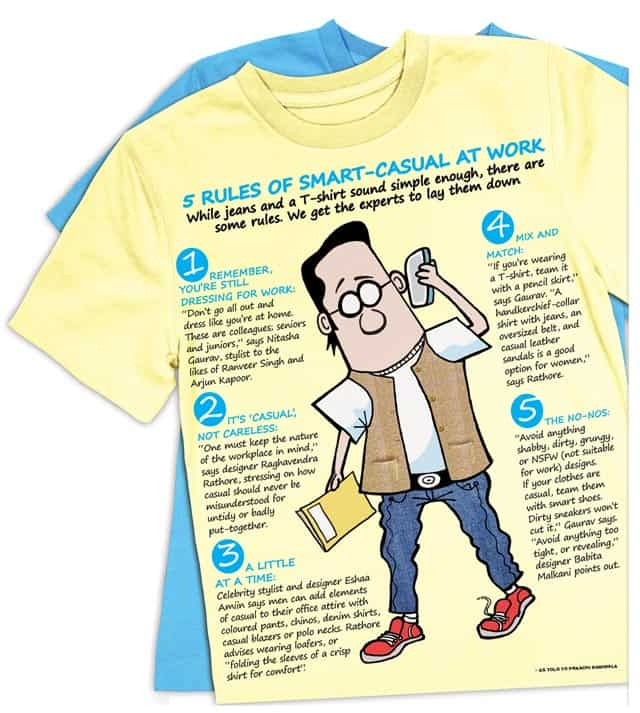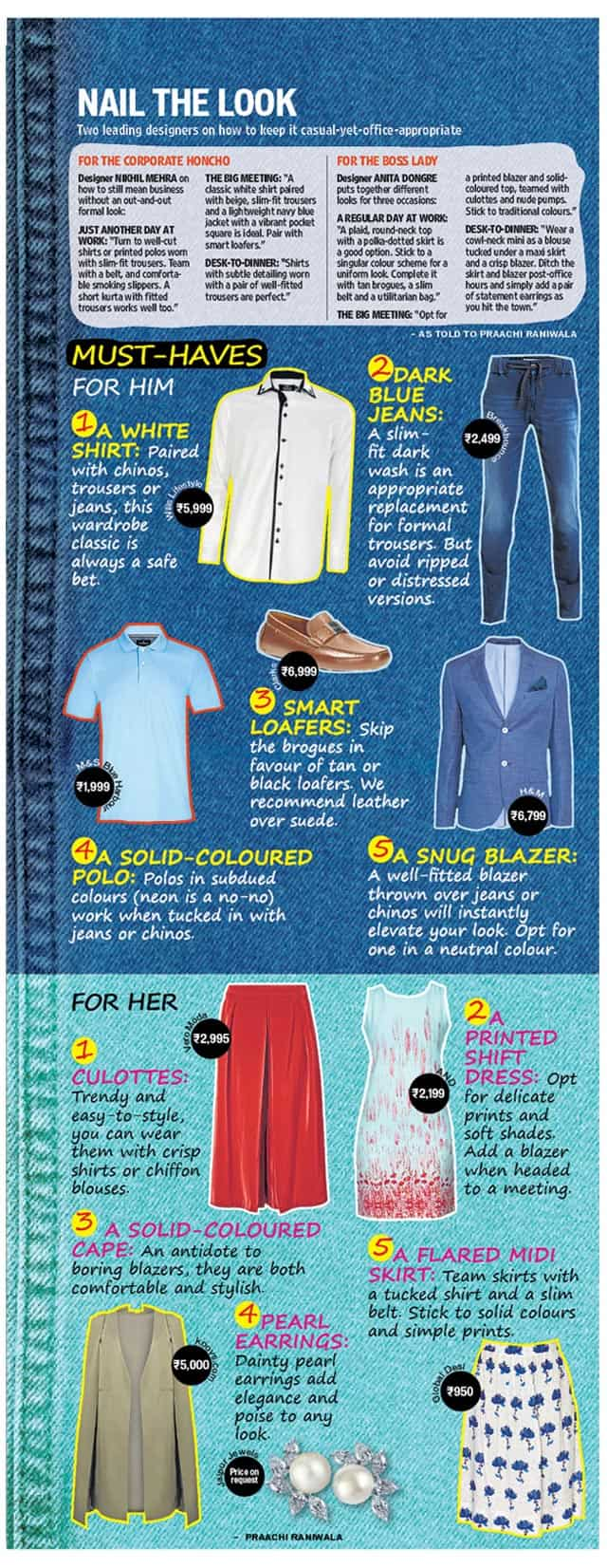Out with the stuffy suits and in with the t-shirts and jeans
Is the ‘smart casuals’ rule at Infosys and HUL the beginning of a fashion revolution at the workplace?
I remember what I wore on the first day of my working life — a crisp white shirt, formal trousers and black leather shoes. College was officially over. And it was time to start ‘dressing seriously’.

It was 2006, and this was the newly opened office of Google, in India. I was a ‘Noogler’ (a new Googler). The joining batch had a few other Nooglers in formals. All around us, though, were men and women in jeans, T-shirts, hoodies bearing names of their alma maters, casual tops, the occasional shorts, open-toe sandals and sneakers. These weren’t just young graduates (like us), but senior managers with B-schools like Wharton and Stanford on their CVs. It was like walking into Hogwarts in robes on your first day, and learning robes had been banished, and everyone just wore Muggle clothes.
One thing was clear. Given a choice, no one liked wearing stuffy formals all the time. Or robes, one imagines.
Nearly a decade since American IT companies brought with them the idea of a relaxed workspace and, with it, casual dressing, Indian companies are beginning to change. Last month, an email sent out to employees at Infosys read: “From Monday, June 1, you can flaunt your smart business casuals all week long…” Richard Lobo, head of employee relations at Infosys, tells us that employees had already been voicing their opinion on workplace dressing: “We listened to the feedback and incorporated it,” Lobo says.
Hindustan Unilever (HUL) followed suit. Towards the end of June, they, too, relaxed their rules. BP Biddappa, executive director, human resources, HUL, says, “The policy allows people to be more comfortable… We have been consciously implementing it over the past one year, and formalised the dress code a few weeks ago.” RIP Friday dressing.

So, can I wear shorts to work?
Well, not quite. It seems Infosys’ “smart business casuals” comes with riders. Mohit Pandey*, a consultant with the company, says guidelines still exist: “‘No gym attire, no sandals or slippers, no shorts…’” But while you can’t dress like you would in college, this is still the beginning of something new. Round-neck T-shirts, sneakers and jeans are fine, and even some of the senior leadership has started dressing down to set the tone. The change is remarkable when you consider the earlier rigid rules, which went so far as to specify sleeve lengths according to the day of the week. “Full sleeves on Monday and Tuesday; half sleeves were okay on Wednesday and Thursday,” Pandey says.
At HUL, the management has been more accepting of jeans and sneakers. Ambika Singh*, who handles consumer insight at its head office in Andheri (East), reckons not much has changed: “Informally, the relaxed dressing norm has been there for a while.”
Jeans therapy
It was the advent of the young and the ‘cool’ IT companies — the likes of Google, Facebook and Twitter — in India that stirred things up. Their founders, the likes of Mark Zuckerberg (Facebook), Larry Page and Sergey Brin (Google), the late Steve Jobs (Apple), were the new role models. And they were doing global product launches and presentations in T-shirts and jeans.
Suddenly, youngsters in comic book tees and backpacks were infiltrating the homogeneity of formal shirts, ties and suits. And the growth of e-commerce ensured that more such companies mushroomed, all modelled on the western work culture. Companies like Myntra, Jabong and Snapdeal, also encourage their employees to dress casually. So does Flipkart, one of the first major Indian e-commerce sites, ever since it started in 2007.
Google India has, arguably, been at the forefront of this change. Its theory is that “allowing causal dressing is a sign of respecting and trusting an individual’s space. It promotes a culture that is not bureaucratic or hierarchical, and gives equal opportunities to gender and age groups,” according to the company’s official spokesperson in India.

Changing rules, (slowly) changing mindsets
Younger businesses want to differentiate themselves from conventional ones. They want to project themselves as in-tune with the changing times. They also hire a lot of youngsters, for whom the allowance of casual dressing is a big draw.
Singh, at HUL, however, says that most of its employees come with prior experience, and are set in the way they dress. So, Biddappa might want employees to “wear casuals any time in the week (sic)”. But Singh says most of the office is still quite formally dressed. She includes herself in that list. She’s always worn trousers to work, and “I don’t intend to change that,” she adds.
Surprisingly, the parent international company, Unilever, adopted relaxed dressing earlier. Bhumika Singh Patnaik, who works with Unilever in Liverpool, UK, says, “The general work-wear pattern is smart casual — knee-length skirts and dresses, or trousers and jeans with tops, cardigans or casual jackets…” The change was jarring for a colleague who made an intra-company move from Mumbai to the UK: “She was surprised by the way people were dressing up to work here. It has been a year, and she still wears her best clothes and shoes to work.”

— By Daniel Rawlison, master barber, Truefitt & Hill
Power dressing
For a lot of employees in India, dressing is determined by the position you hold, and the will-I-be-taken-seriously line of thinking. Often, it’s also about the occasion — a client lunch, a big meeting, an appointment with the CEO.
The idea of dressing up for a big meeting, or a big position, is the most prevalent in banks. A senior manager at amazon.in says that whenever he’s meeting senior guys at companies like HDFC or ICICI, they will be in a suit. “On the other hand, we’ll be in a T-shirt, or a check shirt with sleeves rolled up, at best.” And while those suits may not be coming off anytime soon, Jain says they are accepting (even a little envious) of the fact that “we dress casually”. “The one constant grouse we hear is how they have to be dressed up, even with the mercury touching 40 degrees, while we’re dressed comfortably.”
But change is coming. And, significantly, inside organisations that have had a reputation of being rigid. We’re in the midst of the transition. Pandey, at Infosys, says he’s started wearing casuals three days of the week. Shobhan De, also at Infosys, is glad he can now “concentrate on work rather than on his attire”.
Who knows, someday, you might actually meet bankers in shorts. That would be more magical than JK Rowling doing away with those damn robes.
*Employees whose names were changed on request.
(The writer tweets as @saritray2001)
Catch your daily dose of Fashion, Taylor Swift, Health, Festivals, Travel, Relationship, Recipe and all the other Latest Lifestyle News on Hindustan Times Website and APPs.
Catch your daily dose of Fashion, Taylor Swift, Health, Festivals, Travel, Relationship, Recipe and all the other Latest Lifestyle News on Hindustan Times Website and APPs.





